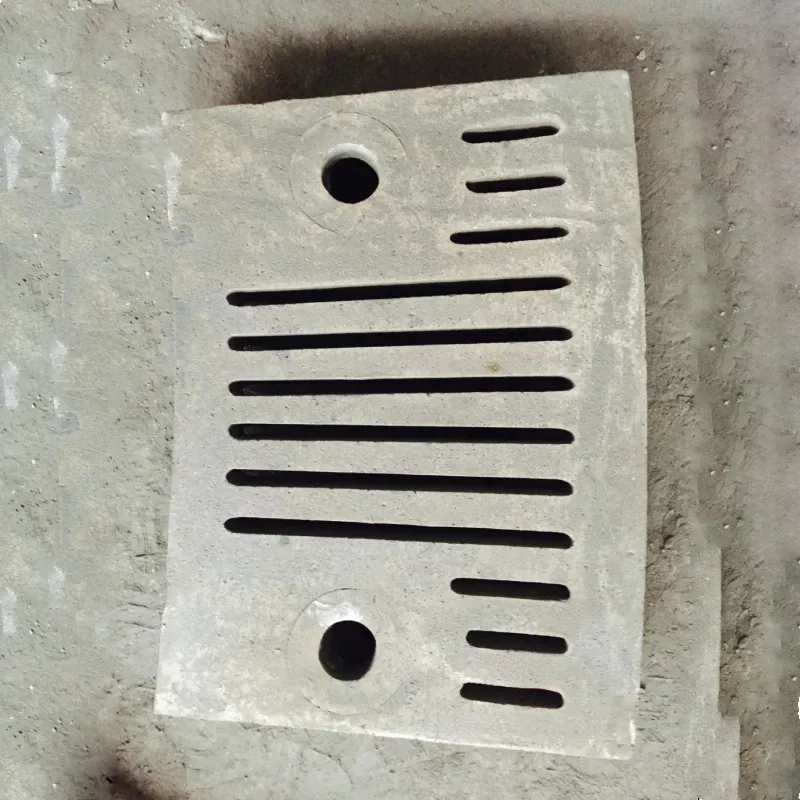Sep . 28, 2025 12:25 Back to list
High-Manganese Steel Lining Plate | Shijiazhuang Chengda Wear Resistant Materials Co., Ltd.
Introduction to High-Manganese Steel Lining Plates
High-manganese steel, also known as Hadfield steel, is a specialized alloy engineered to withstand severe mechanical stress. With a chemical composition of 10%-15% manganese and 0.90%-1.50% carbon, this material exhibits exceptional strength, toughness, and wear resistance. Its unique ability to harden upon impact while maintaining a tough core makes it an ideal choice for critical industrial applications. 
Key Features and Advantages
High-manganese steel lining plates are renowned for their ability to endure extreme conditions. When subjected to high-impact loads, the surface rapidly hardens, while the core retains remarkable toughness. This dual characteristic ensures long-term durability and reduces maintenance costs. The material's secondary surface hardening after wear further enhances its longevity, making it suitable for environments where traditional materials would fail.
Compared to other alloys, high-manganese steel offers unmatched performance in resisting abrasion, extrusion, and impact. Its applications span industries such as mining, metallurgy, and military, where reliability is paramount. 
Technical Specifications
| Parameter | Specification |
|---|---|
| Chemical Composition | Manganese: 10%-15%, Carbon: 0.90%-1.50% |
| Hardness | Surface: 200-300 HB, Core: 120-180 HB |
| Tensile Strength | ≥ 600 MPa |
| Impact Toughness | ≥ 30 J |
| Applications | Ball mills, SAG mills, Mining equipment, Military machinery |
Applications in Industrial Environments
High-manganese steel lining plates are widely used in industries that demand robust materials. In mining and metallurgy, these plates protect equipment from abrasive wear caused by ore and mineral processing. Their use in ball mill liners and SAG mill liners ensures efficient grinding operations. Additionally, advancements in technology have expanded their use to fields like magnetic levitation trains and rock drilling robots, showcasing their versatility.
Company Background: Shijiazhuang Chengda Wear Resistant Materials Co., Ltd.
Founded in China, Shijiazhuang Chengda Wear Resistant Materials Co., Ltd. specializes in manufacturing high-performance wear-resistant materials. The company's expertise in high-manganese steel production has positioned it as a leader in the industry. With a focus on innovation and quality, Chengda provides solutions for global clients seeking durable and reliable industrial components.
Industry Standards and Certifications
As highlighted by the National Institute of Standards and Technology (NIST), the development of advanced materials relies on rigorous testing and adherence to industry standards. High-manganese steel lining plates undergo comprehensive evaluations to ensure compliance with specifications for hardness, tensile strength, and impact resistance. NIST's role in establishing measurement standards underscores the importance of materials like high-manganese steel in driving technological advancements. 1
Why Choose High-Manganese Steel?
The combination of surface hardness and core toughness makes high-manganese steel an optimal choice for high-stress environments. Its ability to self-harden upon impact reduces the need for frequent replacements, lowering operational costs. Furthermore, the material's adaptability to modern technologies ensures it remains relevant in evolving industrial landscapes.
Conclusion
High-manganese steel lining plates represent a critical innovation in industrial materials. Their unique properties, supported by rigorous testing and standards, make them indispensable in sectors requiring durability and performance. For businesses seeking reliable solutions, Shijiazhuang Chengda Wear Resistant Materials Co., Ltd. offers cutting-edge products tailored to meet demanding applications.
References
1 National Institute of Standards and Technology (NIST). Retrieved from https://www.nist.gov/
-
Expert Insights on Fabrica de Molinos de Bolas: Industry Trends & Global Applications
NewsNov.24,2025
-
Expert Insights on Fabricantes de Bolas de Molienda de Acero: Global Applications & Trends
NewsNov.23,2025
-
Leading Fabricantes de Bolas de Molienda: Your Ultimate Guide to Grinding Balls
NewsNov.23,2025
-
Fabricante de Bolas de Molienda – Quality Grinding Balls for Efficient Industry
NewsNov.23,2025
-
Trusted Proveedores de Medios de Molienda for Efficient Industrial Grinding
NewsNov.22,2025
-
Proveedores de Bolas de Molienda: Your Guide to Top Grinding Ball Suppliers & Industry Insights
NewsNov.22,2025
Realted Products
















